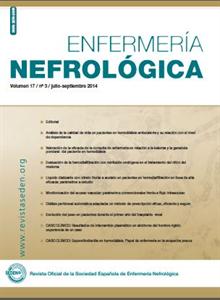Contenido del artículo principal
Resumen
El objetivo del trabajo es analizar los resultados obtenidos tras la introducción de la modalidad de diálisis peritoneal automática adaptada, usando bicarbonato puro como agente tampón, en un grupo de pacientes en programa de diálisis peritoneal automática convencional. Estudio de diseño cuasi experimental, que se realizó entre los meses de febrero y diciembre de 2013, en la unidad de diálisis peritoneal del Hospital Clínic de Barcelona. Los sujetos de estudio fueron 12 pacientes, 7 mujeres y 5 hombres, de dicha unidad en modalidad de diálisis peritoneal automática convencional. Edad media 58±12 años (rango: 34-71). El estudio consistió en comparar dos modalidades de diálisis peritoneal automática. Se inició el estudio con prescripción de diálisis convencional, durante tres meses, para cambiar a modalidad de diálisis adaptada durante el mismo intervalo de tiempo. Y finalizarlo, con tres meses de pauta de diálisis convencional. Se prescribió el mismo volumen total de líquido de diálisis y tiempo de sesión, para cada paciente en ambas modalidades, variando los volúmenes y tiempos de permanencia en función de la modalidad. Se utilizó solución de diálisis con bicarbonato puro y glucosa 1,5%. Todos los pacientes, con día seco. Se monitorizaron las variables al inicio del estudio, y en cada cambio de prescripción. Los resultados obtenidos en diálisis convencional: Kt/v=2,3±0,2, aclaramiento de creatinina=63±8litros/s mana, y ultrafiltración=842±110ml. En diálisis adaptada, Kt/v=2,8±0,2, aclaramiento de creatinina=74±9litros/semana, y ultrafiltración=982±123ml. La diálisis adaptada permite obtener una adecuada eficacia de tratamiento, mejora los parámetros de adecuación de diálisis y ultrafiltración; siendo segura y cómoda.
Palabras clave
Detalles del artículo
Aviso de derechos de autor/a
© Los autores ceden de forma no exclusiva los derechos de explotación de los trabajos publicados y consiente en que su uso y distribución se realice con la Licencia Creative Commons Atribución - No comercial 4.0 Internacional (CC BY-NC 4.0). Puede consultar desde aquí la versión informativa y el texto legal de la licencia. Esta circunstancia ha de hacerse constar expresamente de esta forma cuando sea necesario.




